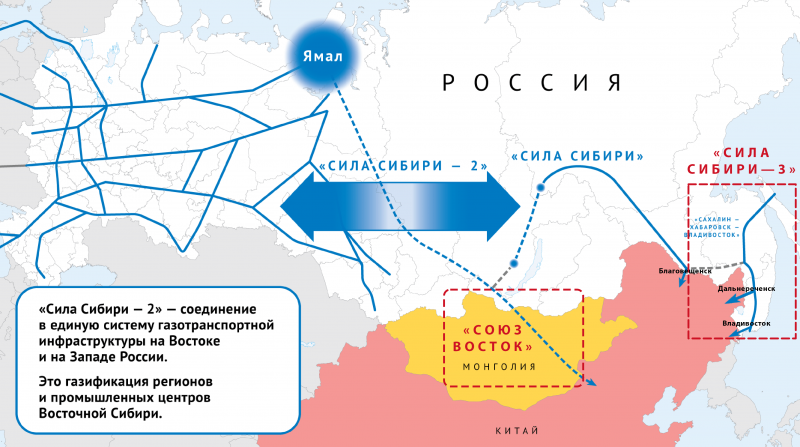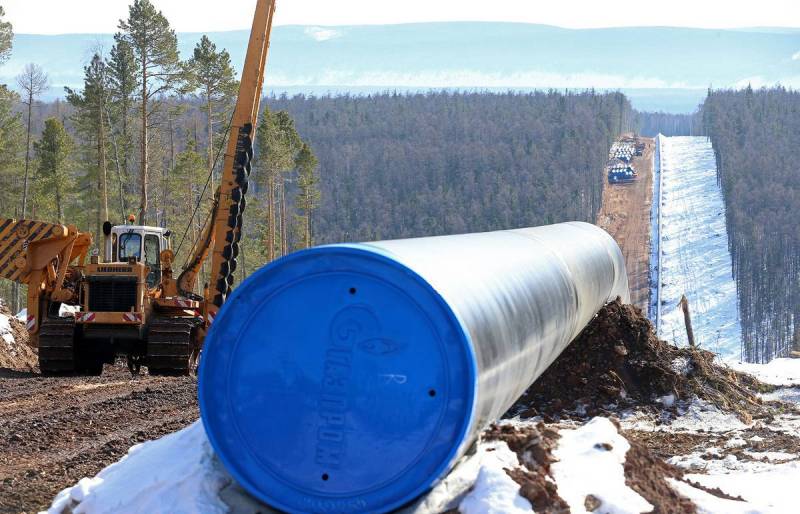Gas exports to China, or "Siberian power" can never be enough
Gazprom does not advertise the cost of contracts under which natural gas is exported to other countries, so one has to be content with information received from energy experts and financial analysts. According to various opinions, blue fuel goes to China at prices ranging from $270 to $450 per 1000 cubic meters. m. Considering that we are talking about long-term supplies of pipeline gas with an oil peg, these are quite reasonable prices. The only question is what is our export volume and what are its prospects? According to forecasts, China's demand for gas will exceed 7 billion cubic meters in 500 years. m, will we be able to occupy at least a fifth of the Chinese market by that time?
In the coming years, Russia needs to compensate for the lost gas export flows to Europe with supplies to China and other countries in the Asia-Pacific region. And work in this direction on our part is carried out tirelessly.
Let us briefly consider the main routes for gas supplies to the Celestial Empire - East Siberian, West Siberian, Far Eastern and through LNG terminals. So far, not all of them have been used at full capacity, and some gas pipelines are at the design stage.

"The Power of Siberia"
The supply agreement between Gazprom and the Chinese state corporation CNPC was signed in 2014. The launch of the main gas pipeline (MGP) with a length of 2200 km took place in December 2019. The contract was concluded for a period of 30 years, and its value is estimated at $400 billion. The design capacity of the MGP is 38 billion cubic meters. m, the output of which should occur in 2025. However, it is possible and practiced to increase the volume of supplies "in real time" at the request of the buyer. Thus, on December 14, 2022, a daily historical maximum of gas exports to China was recorded: the excess of obligations under the contract amounted to 16,5% compared to the approved schedule. And in general, the growth in gas supplies compared to the previous year turned out to be tangible - more than 170%. The Chayandinskoye (Yakutia) and Kovyktinskoye (Irkutsk region) deposits serve as the resource base of the MGP "Power of Siberia".
"Power of Siberia-2"
The former working name is "Altai". The transit part of the gas pipeline through Mongolia will be called Soyuz Vostok, the branch was put into the stage of design and survey work at the end of February 2022. The total length of the IHL is 2600 km. The start of construction is scheduled for 2024, and the launch time is for the end of the 2020s. The design capacity will be 50 billion cubic meters. m (as much Germany bought in better times). The resource base for the Power of Siberia-2 MGP is the Bovanenkovskoye, Kharasaveyskoye and other fields of the Yamal Peninsula, as well as the Chayandinskoye and Kovykta fields of Siberia.
"Power of Siberia-3"
This is nothing more than an export-oriented part of the Sakhalin-Khabarovsk-Vladivostok gas pipeline, branches from which, presumably through Dalnerechensk and Vladivostok, will send blue fuel to China. The supply agreement between Gazprom and the Chinese state corporation CNPC took place in February 2022. The energy contract was signed for a 25-year period. The resource and raw material base for the PGM is the shelf zone of Sakhalin Island, which includes the Kirinskiy, Veninskiy, Ayashskiy and Vostochno-Odoptinskiy blocks of fields. The design capacity is small - 10 billion cubic meters. m., underwater gas production is relatively expensive, but at the same time, the length of the gas pipeline is the shortest of all planned, which compensates for these shortcomings.
Large-capacity LNG complexes
The standard capacity of one technological line of a plant for the production of liquefied natural gas (LNG) is plus or minus 6,5 million tons per year, which, when LNG is converted into a gaseous state, is approximately 7,2 billion cubic meters. m. At the same time, the construction of a technological line and the commissioning of tankers takes about 5 years. These are considerable terms, large investments and technological restrictions. But Russia will have to increase such production capacities in order not to change its dependence on Europe for dependence on China. And all because the gas pipeline to many countries, for example, to India, is either technologically impossible or risky for many geopolitical and geo-economic reasons. In addition, the price of LNG will always be higher than pipeline gas tied to one or two key buyers.
In recent years, China has ranked first in the world in terms of LNG imports (1%), overtaking Japan (21,3%). Russia, as an exporter of LNG to the Middle Kingdom, is somewhere in the 20th or 4th place among such suppliers as Australia, Qatar, Malaysia, Indonesia and the United States. Nevertheless, on our part, there is an increase in exports of liquefied natural gas to China. And in the last year alone, it has grown by a third.
As of the end of 2022, there are 2 large-capacity LNG production complexes operating in our country with a total capacity of about 30 million tons per year, or 33 billion cubic meters. m in terms of pipeline gas:
Sakhalin-2 – As part of this oil and gas project, Russia's first LNG plant was opened in February 2009 with a planned (not to be confused with the maximum) capacity of 9,6 million tons per year. In 2020, it produced 11,6, and in 2021 - 10,4 million tons of LNG. It is planned to build the 3rd line with a capacity of 5,4 million tons per year. Today, more than half of the project belongs to Gazprom through LLC Sakhalin Energy and Gazprom Sakhalin Holding, the remaining share is shared by two Japanese companies - Mitsui & Co (12,5%) and Mitsubishi Corporation (10%). Shell Corporation (27,5%) had to leave as a result of sanctions and government countermeasures, and its share, valued at 94,8 billion rubles, is likely to be sold to Russia's NOVATEK. The exact data on LNG supplies from Sakhalin-2 to China are unknown, but now they are insignificant due to the doubling of its purchases by Japanese companies and most likely amount to less than 1 million tons per year.
Yamal LNG - a complex with a capacity of about 20 million tons per year. The 1st technological line of the plant was launched in December 2017, the 4th line - in May 2021. The project is fully implemented, about 30% belongs to the Chinese CNPC and the Silk Road Fund, 20% - to the French concern TOTAL. The main owner with a 50%+ share is NOVATEK, the largest LNG producer in our country. According to the report of the International Group of Liquefied Natural Gas Importers (GIIGNL), in 2021, the key buyer countries at the Yamal LNG plant were: France - 4 million tons, China - 3 million tons, Spain - 2,5 million tons.
In addition, the launch of the 2023st production line of the large-capacity complex is expected in 1. Arctic LNG 2, the 2nd and 3rd lines of the facility should be put into operation in 2024 and 2026, respectively, which will bring the plant to a capacity of about 20 million tons per year. This project is also owned by NOVATEK (60%), but with a 20% stake in two Chinese companies - CNOOC and CNODC, as well as a 10% stake in the Japan Arctic LNG consortium, which unites two Japanese corporations - Mitsui & Co and JOGMEC, and 10% share of the TOTAL concern. The cost of capital investments in the project is estimated at $21,3 billion.
Almost simultaneously with Arctic LNG 2, in 2024–2025, the complex will be launched Baltic LNGcontrolled by Gazprom. Its capacity will be 13 million tons per year. There are other promising gas liquefaction projects, for example Ob LNG from NOVATEK, the cost and timing of which have not yet been calculated due to sanctions pressure, lack of technology and equipment.
One way or another, we will have to reach the level of the countries leading in the production of LNG, catching up with such giants as Australia, Qatar and the United States, which annually produce from 70 to 80 million tons of liquefied gas to the world market. It seems that this will take at least 10 years. In the meantime… you have to sell LNG at the limit of your production capacity.
So, when deliveries along all the above routes reach a maximum, the total export of Russian gas to China will be more than 100 billion cubic meters. m per year. But this will happen in the early 2030s. Russia will be able to export half of the indicated volume to the Celestial Empire after 2025, that is, in about 3-4 years.
The European Union as a whole, at the peak of mutual cooperation, received about 150 billion cubic meters from Russia through all gas pipelines. m per annum. Thus, in the future, China will replace two-thirds of the previously existing blue fuel exports to Europe. By then, new LNG plants will make up for the remaining third of exports, but these volumes can be expected to go to other countries in the Asia-Pacific region. Although European countries are unlikely to be able to completely abandon Russian raw materials even after a decade and despite all efforts…

Information